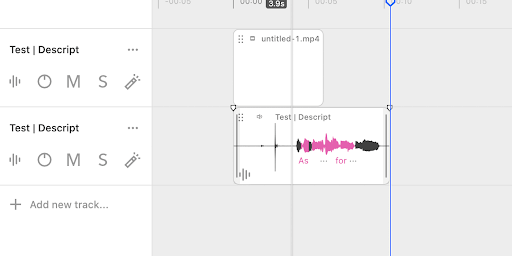What type of content do you primarily create?




Slide presentations are like email and elephant lamps—everyone says they hate them but they’re not going away. Still, you can do better. Like creating a video presentation instead. It’s not that much more work, and you’ll wind up with something far more interesting and engaging.
What is a video presentation?
A video presentation typically refers to a hybrid media experience that combines the visual elements of a slide presentation with components like voice narration, music, and video clips. It can also include interactive transitions or on-screen prompts that invite viewers to click, explore, or respond. The ideal end result is a dynamic, shareable video that clearly lays out a pitch or lesson without you actually having to be there to present it.
TL;DR: It’s a Powerpoint presentation, but way better.
Different types of video presentations
The end goal of your video presentation will likely dictate what form it takes. Here are some of the more common types:
- Educational presentations. Video presentations are a great way to teach skills or concepts. The slideshow element gives you the flexibility to hold the viewer’s hand as you move from one step to another, and you can even intersperse clips demonstrating any tricky or hard-to-explain parts.
- Sales presentations. Let’s say you have a product or service to sell. (Congrats!) In an ideal world where everyone had unlimited time, you could travel the globe singing its praises. In reality, you probably have a life that prevents you from spending all your time doing that. The solution? Record one kickass presentation and post or distribute it.
- Investor pitches. In a similar vein as the sales presentation, putting your pitch to investors in video form gives you the potential to reach way more possible investors than you would going from conference room to conference room.
- Promotional videos. Since promotional videos tend to be for a larger audience than, say, investor pitches, they skew more toward the video end of the spectrum rather than the slideshow end. Nevertheless, a demo or some helpful graphics can be a welcome alternative to the same old commercial or ad. No matter how powerful the presentation software, though, you’ll still have to channel your own inner Billy Mays.
- Onboarding videos. Save the spiel and put all the information for hirees together in one super snazzy video presentation. Especially as more people work remotely, a quality video can make newbies feel like part of the team. While this probably shouldn’t replace quality one-on-one training, it can help you save a bit of time going over the basics.
- Informational videos. A well-delivered lecture is all well and good, but amping up its impact with some visual aids can take it to the next level and turn a dry recitation of facts into an actually engaging video.
- Social media videos. Perfect for quick product demos, tutorials, or campaign announcements in snackable formats. Their short runtime and visual punch make them ideal for platforms where you only have a few seconds to grab attention.
Why make a video presentation?
Making a video presentation may seem like an extra step compared to a classic slideshow. But let’s be honest: we’ve all suffered through a soul-sucking slide deck or two. Adding a bit of voice, music, and dynamic visuals can rescue your audience from that fate. Beyond the sheer wow factor, video presentations help people retain information and feel more engaged, which goes a lot further than flipping through lifeless slides.
- Video presentations can accommodate multiple learning styles. People retain information in different ways, so the more methods you can find to convey information in your presentation, the more likely your audience is to hold on to your message. You can give people assignments for tactile learners, graphics for the visual learners, etc.
- Video presentations offer more avenues to engage your audience. Raise your hand if you’ve ever drifted off while scrolling through a slide presentation. To be fair, not all Powerpoints are interminable slogs through text-heavy slides created by people who have no idea how to make a presentation…but a lot of them are. And even for the ones that aren’t, the added dynamism they’d get from the option of adding some music or voice work in a video presentation would still make them more enjoyable for their audience.
- Video presentations are convenient. Instead of juggling calendars and stressing about scheduling your pitch, you can just send a link and have everyone watch your presentation when they actually want to or have time to. You’ll wonder why you ever set up meetings to begin with.
- Video presentations are efficient. You most likely can’t fit all the information you need to on a slide (though people definitely try). By the same token, unless you’re speed-reading, you face a similar issue with voiceover. But when the two join forces, the balance is just right.
How to create a video presentation with Descript
The easiest way to create a high quality presentation with Descript is to create a video in your slideshow creator of choice and then import it into Descript for some polish. This step-by-step guide will use a presentation made in Prezi as an example.
- Create your slide presentation in Prezi, then record it at the pace you want using Descript’s built-in screen recorder. Or Prezi’s—this is a feature on most comparable platforms nowadays.
- If you recorded in Prezi, download the presentation; this will turn your slides into a video. If you recorded in Descript, skip to step 5.
- Next, open Descript (i.e. our video editor) and start a new project if you don’t already have one.
- You can add your video to the timeline either with a simple drag and drop from your Finder or by clicking “Add new…” in the sidebar and choosing the video file from there.
- Once your slideshow is in your timeline, you can make the voiceover part of your presentation by playing the video in the timeline and recording yourself reading your script as it plays. Then let Descript’s AI editing features handle the cleanup—removing pesky filler words and smoothing out awkward pauses. The result? A polished final version without hours of manual edits.
- Add your voiceover to the timeline, again by dragging and dropping or by selecting from the “Add New” menu.
- Finally, it’s time to join the video and audio by matching your voiceover to the presentation. One easy way to do this is to match up the start of the audio waveform with the start of the video. Rather than working with one big piece of audio, you can break your audio up into chunks to make it easier to move pieces around to match the video.

- Once you’ve matched up your elements, you can export your project and publish it to your platform of choice. Mazel tov—you just made a video presentation.
You can also add captions and titles, pull in pictures or video overlays, and play around with other effects. But first, try starting simple. Once you get the hang of it, there are all kinds of modifications you can make that will elevate your slideshow into a full-on event.
Mazel tov—you just made a video presentation.
Ready to add the finishing touches or start a new project? From crafting a sales pitch to refining an onboarding series, there’s always another reason to hit ‘record.’ Keep experimenting—over time, you’ll figure out exactly what style grabs your viewers and gets them excited to learn more.
Frequently asked questions
How can I turn my slides into a video presentation?
You can start by recording your slideshow using a tool like Descript’s screen recorder. Or, export your slides as a video file from your slideshow app, then import it into Descript to add voiceover, captions, and any final edits. Finally, publish or share the polished video where you’d like.
How do I record my screen for a video presentation?
In Descript, click Record, select your screen and audio inputs, then present your slides or other content as you speak. Stop recording when finished—Descript automatically brings the file into your script for easy editing and cleanup.
Is the 5-5-5 rule important for making a video presentation?
The 5-5-5 rule suggests using no more than 5 words per line, 5 lines of text per slide, and 5 text-heavy slides in a row. It helps keep slides visually clear. But because video presentations can also include narration, clips, or music, you may adjust your format to suit your content and audience.
Is Descript a good choice for creating video presentations?
Yes. Descript simplifies every step—recording, editing, and finalizing your video. You can import slides, add voiceover, use automatic captions, and even remove mistakes with text-based editing. This all-in-one approach helps create polished presentations without extra tools.





























%201.svg)










